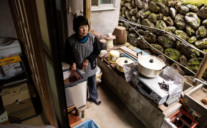
KAMIKATSU ‘One, two, three....” Hatsue Katayama, a 70-year-old Japanese housewife, is kneeling at a low table in her home while counting aloud from a handwritten list.
She continues, without drawing breath, until she reaches 25: “That’s the number of rubbish categories we have at home.”
Mrs Katayama’s diligent disposal habits are reflected in the clusters of small bins throughout the family home, devoted to clear plastics, bottle tops, toothbrushes and socks.
More remarkable than her bin collection, however, is the fact that she is not alone: the practice is shared by almost all residents of the 1,500-strong community of Kamikatsu, a speck of a village located between folds of forested mountains in Tokushima Prefecture, southwest Japan.
The village is fast acquiring a fame that belies its remote location and diminutive size after masterminding an ambitious environmental project: it is determined to become Japan’s first zero-waste community by 2020.
And it seems to be on track to reach its goal. As governments around the world grapple with their sustainable goals, Kamikatsu is emerging as a global prototype of a zero-waste community.
Fifteen years after officials unveiled their goals in a manifesto, Kamikatsu has a recycling rate of around 80 per cent, with residents dividing refuse into 45 categories at a communal rubbish station.
There is a “reuse” shop for abandoned items, a “remake” boutique for recycled crafts, an accreditation system monitoring the eco-standards of local businesses and points cards to reward residents for recycling.
The construction of a hi-tech new multi-million pound Zero Waste centre - scheduled to open next spring - has received government go-ahead.
Perhaps most significantly, many residents say a zero-waste lifestyle has not only helped the environment and slashed disposal costs - it has also boosted their quality of life, improved health, enforced a sense of community and slowed the pace of depopulation that is rife across rural Japan.
“Life is so different here now,” said Mrs Katayama, who described using compost created from food waste to grow broccoli and lettuce. “Like most people, we used to burn our rubbish in the rice fields, but it was so unhealthy. Now, the air is cleaner and it looks more beautiful.”
Her husband Fumiaki, 67, a retired farmer and town council member, added: “This is a very small town, but our activities are now being highlighted around the world. We hope this idea will spread and help with the problems of global warming.”
The heart of Kamikatsu’s zero-waste movement is the Gomi Station (“rubbish station”), a sprawling warehouse surrounded by steep snow-fringed forests where residents bring their own rubbish and divide it into as many as 45 categories.
“Kamikatsu residents bring their own waste here by car,” explained Terumi Azuma, chief officer of the Zero Waste Academy, the NPO behind the station and a raft of eco-initiatives. “Each category of rubbish is labelled to show residents how much money it costs to recycle per kilo, or how much money we can make from selling it.”
The maths are impressive: the village’s annual rubbish disposal bill has dropped to just under pounds 17,000 (2.5 million yen) - less than a sixth of the pounds 107,000 (15.9 million yen) it would cost to dispose of the same amount using incinerators or landfills.
The concept, however, is not confined to rubbish sorting. Azuma, whose late mother was an original pioneer of the concept, added: “What’s most important is changing people’s mentalities. It’s not just about recycling - it’s about people not creating so much potential waste from the start.”
Among a steady stream of locals dropping off bags of rubbish (or, in the case of one couple, an entire truckload) was Yoshiteru Ishimoto, a 79-year-old pensioner. “I come here once, maybe twice a week,” he said. “I see friends and it’s quite sociable. And best of all, it’s making Kamikatsu clean and beautiful again.”
With more than half of Kamikatsu’s population aged over 65, the rubbish station created a vital social hub for residents, according to Kazuyuki Kiyohara, its manager.
Skilfully dismantling a food blender with a screwdriver, he said: “People probably thought they would be too lazy to separate rubbish at first. But everyone chats and helps one another. It’s opened up the community.”
As the 2020 Zero Waste deadline approaches, local government officials are stepping up attempts to highlight the village’s initiatives.
Next spring, the station will relocate into a contemporary new building made from local cedar wood and discarded doors, windows and furniture with accommodation and research facilities aimed at attracting global eco-experts.
The 450 million yen (pounds 3 million) price tag, which is partially funded by central government, has provoked mixed reactions among locals, although one person unwaveringly won over is Yasushi Hanamoto, the Kamikatsu mayor.
He said: “It can be hard to change the minds of older people who tend to be more set in their ways. But we started our Zero Waste policies many years ago, so younger generations have been raised in an environment where this is natural to them. Before then, we thought the village would disappear.
“We realised we had to change our mentalities in order to survive. Some people still move to cities - but some young people are also starting to move here, inspired by the idea of a zero- waste lifestyle.”
Among the trickling influx of outsiders is Yasuyoshi Wada, 36, a former barman who swapped the crowds and neon of Tokyo for the slow life in Kamikatsu three years ago.
Wada is manager of a space that perhaps best reflects the new face of Kamikatsu - Rise & Win Brewing Co BBQ and General Store, home to a craft brewery, shop and restaurant.
It is also impossible to miss: designed by the same architects as the new rubbish station, one double-height wall is covered entirely in a jigsaw puzzle of abandoned windows.
Inside are walls of local cedar wood plus products ranging from teas and bags made from newspapers to a range of Kamikatsu craft beers.
“It’s such a different lifestyle from Tokyo where it’s noisy and busy and you’re exposed to constant information,” said Wada. “I love being in nature and having time to read. I’ve even learnt to make soba noodles. But the most important thing is zero waste - and the concept of reduce, recycle and reuse.”
It is this zero-waste concept that Kamikatsu is counting on to not only reduce its carbon footprint but attract a new generation of residents - and keep the village alive.
The Telegraph











